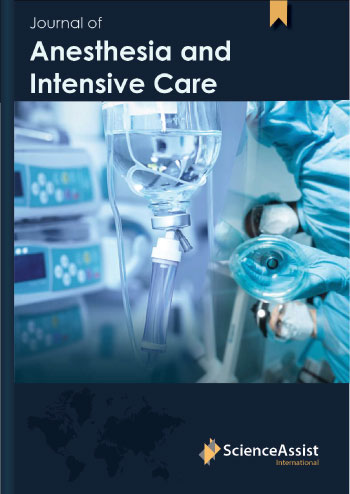
Volume 1, Issue 1 (2020)
Proper postoperative analgesia is thought to improve the postoperative prognosis by preventing painrelated complications [1]. Acute pain after total knee arthroplasty (TKA) has a substantial effect on functional recovery and patient satisfaction. Multimodal analgesia, including the femoral nerve block (FNB) and local infiltration anesthesia (LIA), is known to be effective for the amelioration of early postoperative pain after TKA [2,3]. However, patients experience rebound pain after the effects of FNB and LIA are diminished [4].
Although opioids are extremely useful analgesic agents, their use is associated with side-effects, such as postoperative nausea and vomiting (PONV), and respiratory depression [5]. Moreover, postoperative pain is multifactorial in origin: it can arise from nociceptors and in response to inflammation, and the current practice involves the combination of multiple analgesics. Therefore, multimodal analgesia that combines nonopioid analgesics and peripheral nerve blocks to reduce opioid consumption has become the mainstay of postoperative pain control in recent years. Flurbiprofen is an injectable nonsteroidal anti-inflammatory drug (NSAID), which is generally administered to achieve postoperative analgesia in Japan [6]. The analgesic effect of intravenous acetaminophen is comparable to that of NSAIDs in patients with moderate postoperative pain [7]. However, few studies have compared the postoperative analgesic effects of flurbiprofen and acetaminophen after TKA.
This prospective, randomized, open-label, and placebo-controlled study aimed to determine whether acetaminophen and flurbiprofen were effective analgesic adjuvants to the FNB and LIA after TKA.
MATERIALS AND METHODS:
Patients This study was approved by the Institutional Ethics Committee, and written informed consent was obtained from each patient. This open-label randomized clinical trial included 75 patients with an American Society of Anesthesiologists physical status of 1 or 2, weighing 50– 70 kg, who underwent TKA under general anesthesia at Nagasaki Rosai Hospital between October 2017 and April 2019. The exclusion criteria included liver and renal dysfunction, and a medical history of peptic ulcers and asthma. None of the patients received any pre-anesthetic medication.
Study Protocol
Patients were randomly allocated to one of three groups: group A (n = 25), which received intravenous acetaminophen, group F (n = 25), which received flurbiprofen intravenously, and group C (n = 25), which received saline as the control. Randomization was performed by the responsible anesthesiologist using the sealed-envelope system.
Patients received a continuous infusion of remifentanil 0.5 μg/kg/min and propofol 5 μg/mL for 2 min followed by 3 μg/mL to achieve the desired effect-site concentration using a target-controlled infusion system (TCI pump, TE371, Terumo, Tokyo, Japan). Rocuronium (0.8 mg/kg) was administered to facilitate tracheal intubation after loss of consciousness. The effect-site concentrations of propofol and remifentanil were titrated to maintain the bispectral index score between 40 and 60 after tracheal intubation. All patients received ultrasound guided FNB with 0.25% levobupivacaine 30 mL before surgery and LIA with 0.25% levobupivacaine 30 mL into the posterior capsule of the knee before cementing the components. All patients received a bolus administration of fentanyl 250 μg after cementing the components (approximately 30 min before the end of surgery). Patients in group A received acetaminophen 1000 mg (Acelio® Intravenous Injection 1000 mg, TERUMO, Tokyo, Japan) intravenously every 6 h, patients in group F received flurbiprofen axetil 50 mg (ROPION® Intravenous 50 mg, Kaken, Tokyo, Japan) intravenously every 6 h, and those in group C received 100 mL of saline intravenously every 6 h (as the control). The administration of each drug was started prior to skin closure and continued for 24 h after surgery. Patients were administered diclofenac sodium 50 mg, loxoprofen 30 mg, or pentazocine 15 mg as rescue analgesics after surgery, if needed. The nursing staff evaluated the postoperative pain using a numerical rating scale (NRS; 10 points from 0 to 10) 1, 2, 6, 12, and 24 h postoperatively. NRS scores were evaluated just before analgesic drug injection.
1. Amar S, Chitranjan S. Pain management and accelerated rehabilitation for total hip and total knee arthroplasty. J Arthroplasty. 2007; 22 (7 Suppl 3): 12-5
2. Terkawi AS, Mavridis D, SEssler DI, Nunemaker MS, Doais KS, Terkawi RS, et al. Pain management modalities after total knee arthroplasty. A network meta-analysis of 170 randomized controlled trial. Anesthesiology. 2017; 126(5): 923-37.
3. Gi Eri, Yamauchi M, Yamakage M, Kikuchi C, Shimizu H, Okada Y, et al. Effects of local infiltration analgesia for posterior knee pain after total knee arthroplasty: comparison with sciatic nerve block. J Anesth 2014; 28(5): 696-701.
4. Choi S, O’Hare T, Gollish J, Paul JE, Krender H, Thorpe KE, et al. Optimizing pain and rehabilitation after knee arthroplasty: A two-center, randomized trial. Anesth Analg. 2016; 123(5): 1316-24.
5. Tunali Y, Akçil EF, Ozlem KD, Ayse C. T, Koksal GM, Akbas S, et al. Efficacy of intravenous paracetamol and dexketoprofen on postoperative pain and morphine consumption after a lumbar disk surgery. J Neurosurg Anesthesiol. 2013; 25(2): 143-7.
6. Nonaka T, Hara M, Miyamoto C, Sugita M, Yamamoyo T. Comparison of the analgesic effect of intravenous acetaminophen with that of flurbiprofen axetil on postbreast surgery pain: a randomized controlled trial. J Anesth. 2016; 30(3): 405-9.
7. Yamashita K, Fuskusaki M, Ando Y, Fujinaga A, Tanabe T, Terao Y, et al. Postoperative administration of intravenous flurbiprofen axetil reduces postoperative pain for spinal fusion surgery. J Anesth. 2006; 20(2): 92-5.
8. Kim EJ, Shim JK, Soh S, Song JW, Lee SR, Kwak YL. Patientcontrolled analgesia with propacetamol-fentanyl mixture for prevention of postoperative nausea and vomiting in high-risk patients undergoing spine surgery: a randomized controlled trial. J Neurosurg Anesthesiol. 2016; 28(4): 316-312.
9. Svensson CI, Yaksh TL. The spinal phospholipasecyclooxygenase-prostanoid cascade in nociceptive processing. Ann Rev Pharmacol Toxicol. 2002; 42: 553-83.
